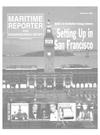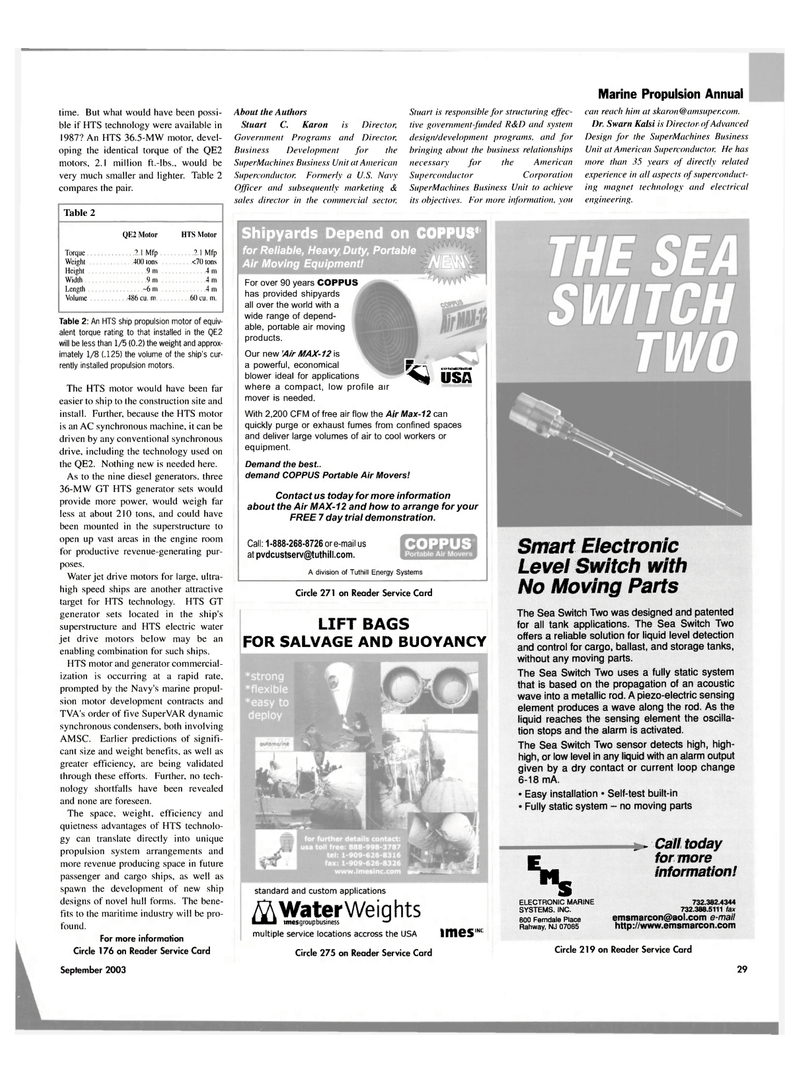
Page 29: of Maritime Reporter Magazine (September 2003)
Read this page in Pdf, Flash or Html5 edition of September 2003 Maritime Reporter Magazine
time. But what would have been possi- ble if HTS technology were available in 1987? An HTS 36.5-MW motor, devel- oping the identical torque of the QE2 motors, 2.1 million ft.-lbs., would be very much smaller and lighter. Table 2 compares the pair.
Table 2
QK2 Motor HTS Motor
Torque. .2.1 Mfp 2.1 Mfp
About the Authors
Stuart C. Karon is Director,
Government Programs and Director,
Business Development for the
SuperMachines Business Unit at American
Superconductor. Formerly a U.S. Navy
Officer arid subsequently marketing & sales director in the commercial sector.
Stuart is responsible for structuring effec- tive government-funded R&D and system design/development programs, and for bringing about the business relationships necessary for the American
Superconductor Corporation
SuperMachines Business Unit to achieve its objectives. For more information, you
Marine Propulsion Annual can reach him at [email protected].
Dr. Swam Kalsi is Director of Advanced
Design for the SuperMachines Business
Unit at American Superconductor. He has more than 35 years of directly related experience in all aspects of superconduct- ing magnet technology and electrical engineering.
Weight 400 tons <70 tons
Height 9 m 4 m
Width m 4 m
Length ~6 m 4 m
Volume 486 cu. m 60 cu. m.
Table 2: An HTS ship propulsion motor of equiv- alent torque rating to that installed in the QE2 will be less than 1/5 (0.2) the weight and approx- imately 1/8 (.125) the volume of the ship's cur- rently installed propulsion motors.
The HTS motor would have been far easier to ship to the construction site and install. Further, because the HTS motor is an AC synchronous machine, it can be driven by any conventional synchronous drive, including the technology used on the QE2. Nothing new is needed here.
As to the nine diesel generators, three 36-MW GT HTS generator sets would provide more power, would weigh far less at about 210 tons, and could have been mounted in the superstructure to open up vast areas in the engine room for productive revenue-generating pur- poses.
Water jet drive motors for large, ultra- high speed ships are another attractive target for HTS technology. HTS GT generator sets located in the ship's superstructure and HTS electric water jet drive motors below may be an enabling combination for such ships.
HTS motor and generator commercial- ization is occurring at a rapid rate, prompted by the Navy's marine propul- sion motor development contracts and
TVA's order of five SuperVAR dynamic synchronous condensers, both involving
AMSC. Earlier predictions of signifi- cant size and weight benefits, as well as greater efficiency, are being validated through these efforts. Further, no tech- nology shortfalls have been revealed and none are foreseen.
The space, weight, efficiency and quietness advantages of HTS technolo- gy can translate directly into unique propulsion system arrangements and more revenue producing space in future passenger and cargo ships, as well as spawn the development of new ship designs of novel hull forms. The bene- fits to the maritime industry will be pro- found.
For more information
Circle 176 on Reader Service Card
Shipyards Depend on COPPUS* for Reliable, Heavy Duty, Portable
Air Moving Equipment!
For over 90 years COPPUS has provided shipyards all over the world with a wide range of depend- able, portable air moving products.
Our new Air MAX-12 is a powerful, economical blower ideal for applications where a compact, low profile mover is needed. air m
Wj**' HHWM1M % USA
With 2,200 CFM of free air flow the Air Max-12 can quickly purge or exhaust fumes from confined spaces and deliver large volumes of air to cool workers or equipment.
Demand the best- demand COPPUS Portable Air Movers!
Contact us today for more information about the Air MAX-12 and how to arrange for your
FREE 7 day trial demonstration.
Call: 1-888-268-8726 ore-mail us at [email protected].
A division of Tuthill Energy Systems
Circle 271 on Reader Service Card
LIFT BAGS
FOR SALVAGE AND BUOYANCY standard and custom applications
M Water Weights LJLJ imesgroupbusiness —' multiple service locations accross the USA llfieSINC
Circle 275 on Reader Service Card
Smart Electronic
Level Switch with
No Moving Parts
The Sea Switch Two was designed and patented for all tank applications. The Sea Switch Two offers a reliable solution for liquid level detection and control for cargo, ballast, and storage tanks, without any moving parts.
The Sea Switch Two uses a fully static system that is based on the propagation of an acoustic wave into a metallic rod. A piezo-electric sensing element produces a wave along the rod. As the liquid reaches the sensing element the oscilla- tion stops and the alarm is activated.
The Sea Switch Two sensor detects high, high- high, or low level in any liquid with an alarm output given by a dry contact or current loop change 6-18 mA. • Easy installation • Self-test built-in • Fully static system - no moving parts s
ELECTRONIC MARINE
SYSTEMS. INC. 800 Ferndale Place
Rahway, NJ 07065 ^ Call today for more information! 732.382.4344 732.388.5111 fax [email protected] e-mail http://www.emsmarcon.com
Circle 219 on Reader Service Card
September 2003 29

 28
28

 30
30
